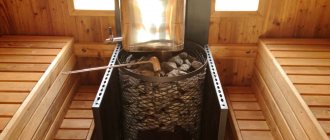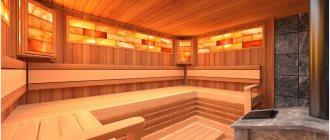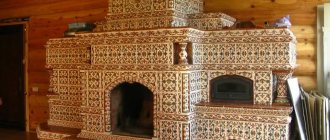Despite the fact that most stores will offer you many models as stoves for the Russian bath, in fact it is suitable for it very few options. And the task of this article is to name the most important conditions that such a stove must satisfy, to suggest which of them are found in sale, and which ones will have to order or do it yourself, in general, to provide reliable and complete information about how and with what to properly heat a Russian steam room.
Stove for a Russian bath: what requirements should it meet?
To begin with, you must decide on this: do you share the traditional view of the conditions of a Russian bath or are you inclined to modernize these conditions themselves in accordance with the available equipment ?
Principles of Russian steam room
First, let’s remember what a Russian-style bathhouse is as it was a long time ago. The temperature in such a steam room was kept in the range from 45 to 55 degrees. But it wasn't cold.
During the period of active soaring, all drafts stopped . This is necessary in order to form a steam “pie,” when hot, finely dispersed steam from a closed heater rises to the ceiling and forms the top layer of the cake. From there, the bathhouse attendant scoops up steam with a broom and lowers it onto the body of the person steaming. The temperature of the steam leaving the furnace could be above 100 degrees, but under the ceiling it was cooled to 80 degrees.
The duration of the steaming was about
20 minutes , after which the steam room was ventilated and again brought to its original state, in which it met a new batch of steamers.
The length of the period is not accidental - it is the time during which the necessary conditions can be maintained without much difficulty. The ratio of temperature and humidity was chosen ideally because these two parameters can cause acute discomfort if their balance is disturbed.
IMPORTANT! If you increase humidity and temperature at the same time, a person will not tolerate such a bath. The higher the humidity, the lower the temperature should be; the higher the temperature, the lower the humidity should be so that those steaming do not suffocate, overheat or freeze in the steam room.
So, here is a list of conditions that must be met:
- The temperature should be maintained stably in the specified range of 45-55 degrees.
- Humidity must also be maintained, otherwise unacceptable drying of the air .
- Convection must be completely adjustable, that is, at the right moment it must stop completely .
- The steam generator (heater) should produce just enough steam (without strong cooling of the stones) to completely fill the space under the ceiling .
Nowadays, a bathhouse in which the temperature regime differs from the traditional one is called “Russian”. This also depends on the ovens used. It is difficult with a metal stove to bring the stones to the required condition so that they glow crimson and so that the temperature in the steam room is 55 degrees. Therefore, the temperature rises, people adapt, ultimately believing that this is a real Russian bathhouse.
Russian sauna stove with closed heater
Well, the main thing here is that people are satisfied, because for the sake of the traditional one you need to invest well from the very beginning , and not everyone is ready to do this. In the end, we can talk about a simple country bathhouse of tiny sizes.
What materials, types of heaters and heating are suitable for it?
Now, after the necessary conditions for a Russian steam room have been listed, it is worth telling how many of the existing variety of stoves are capable of reproducing these conditions.
Let's start with the material from which the stove is made. Today the choice is the same as in the last century - either brick or metal . So, a brick oven should be considered the only one capable of completely reproducing the conditions of a Russian bathhouse .
The “correct” stove for a Russian bath
This is easy to explain: in order to maintain a fairly low temperature in a room with a working stove, it must be made of a material with high thermal inertia . brick and stone fit this definition .
By the way, it’s worth mentioning what a hot and cold . “Cold” is just a definition that you can touch it with your hand without harming your health. And you can’t touch something “hot” without getting burned.
It is logical that the first category will include stoves made of brick or finished with brick, or natural stone . And the second ones are metal stoves, without lining. In our case, preference is given to “cold” stoves.
Metal heats up easily and gives off heat easily (and even in the harsh range of infrared radiation), so you will have to work hard to force a metal furnace to keep a low temperature. Of course, you can make a brick screen or a stone casing , this will increase thermal inertia, but the metal will still be in a hurry to give off heat.
So, we are betting on a brick oven . It will provide the desired temperature in the bath. What does the quality of steam depend on? From the temperature of the stones, of course. And here we have two options: an open heater and a closed one .
IMPORTANT! An open heater , that is, with stones not covered by anything on top (or even on the sides), cannot provide heating to the crimson glow temperature , at which the stone steam is of optimal quality in terms of heat and dampness.
This means that only a closed heater , with a door behind which there is a cavity filled with stones, is suitable for a Russian bath.
But even here there is plenty to choose from: closed heaters come in direct and indirect heating.
A direct heating heater is washed by flames and hot stove gases; soot and other combustion products are constantly deposited inside and burned out. And the steam from such a heater invariably smells of smoke. But this is the very desired “light steam”.
The indirect heating stove is separated from contact with the fire by a metal partition. Accordingly, heating occurs indirectly and part of the heat is lost during transmission.
And here you should weigh all the pros and cons:
- if there is a direct heating heater in the stove, then on the one hand you get the desired crimson glow of the stones, and on the other hand, the stove must be stopped so that you can add water to the stones;
- If the heater is indirectly heated, then its contents will take longer to heat up and the temperature will ultimately be lower than with direct heating. But the stove can continue to burn (by the way, such stoves are defined as “continuous action” in contrast to the “intermittent action” described above).
So, for the bathhouse we are striving for, the best heater will be a closed one with direct heating, and a stove, accordingly, of intermittent operation . This promises certain difficulties during operation, but tradition is tradition.
Now let's figure out what fuel is best to use in our bathhouse.
Temperature
Such temperatures, 800-900 °C, are certainly a serious test for all firebox materials. Cast iron grates burn out faster or sag under the weight of stones. The steel door darkens in extreme temperatures. The heat resistance of vermiculite is put to the test. You should not put any bath stones into such a heater. Some types of stones shoot and burst, others crumble and spill sand into the firebox or melt. The stones must withstand instantaneous temperature changes from 900 to 300 degrees after contact with water and reheating to a crimson color.
A direct heating stove requires owners to spend more money upon purchase, more time during installation, and more hassle during lighting and operation.
In return, it gives great pleasure to the steamers. Since there is no air convection in such a sauna, the air temperature in them rarely heats up above 70 °C. The amount of water poured onto the stones is much less than usual, and the steam is really light and hot. Simple, unpretentious heaters, the use of which requires minimal cost and effort from the user, have become widely used around the world. However, those who have tested direct heating ovens readily admit their obvious advantages over conventional ovens. February 14, 2022
Stove for a Russian wood-burning bath
Firewood is the most common type of fuel in our country. The reasons are simple - gas and electricity , even if installed, are expensive, but firewood is always available and its price is low.
There is, of course, also coal , but it is unprofitable to heat a stove with it for the simple reason that it gives off too much heat during combustion - this is not so good for a sauna stove, especially from ordinary steel , which oxidizes in extreme heat, the sheets become thinner, turning into scale.
In general, if we are talking about metal stoves that are poorly suited for a Russian steam room, then those made from chrome-plated stainless steel (especially with a chromium content of 17%) and cast iron , from heat-resistant grades of cast iron, will be more durable. Chromed ones are not budget models, so let's focus on cast iron ones - there aren't many of them on the market, but they still exist.
Brick oven
Brick stove for a Russian bath with a closed metal heater
The traditional option is a brick stove, which is heated with wood. However, it is precisely this circumstance that turns the work of a stoker into real skill. After all, brick behaves quite capriciously, especially in ovens that are not heated daily .
IMPORTANT! First, such a stove must be dried , then slowly warmed up so that it does not crack from the rapid transition from cold to heat.
The main differences between different models of brick stoves lie in the presence or absence of flue labyrinths - that is, stove gases can either immediately go into the chimney or lose heat in the labyrinths, increasing the efficiency of the stove. Differences in the design of the heater are also acceptable : it is usually closed, but inside it can be made with direct and indirect heating , and the design can also be improved by making indirect heating through a hood that collects heated gases.
Stones in a direct heating stove of a brick oven in a Russian bath
To heat a brick stove with wood, you need to start either in the evening and continue the next day, or spend 4 hours heating it at a time.
As for the purchase, everything is clear here - you buy materials and hire a stove maker if you yourself do not know this profession. A choice must be made during the construction process in order to determine the parameters of the foundation for the stove.
Cast iron stove
Many people are aware of the durability of a cast iron stove. And when steel models dominate the market, cast iron models do not lose their reputation. Of course, there are fewer manufacturers of such stoves, but they exist, as well as some choice for the consumer.
We are starting a conversation about cast iron fireboxes for a simple reason: they are indeed often associated with a real Russian bathhouse. Many bathhouse owners are interested in which metal stove will be the best. And the answer “none” does not suit them.
Well, if so, then we will at least try to explain how to improve a cast-iron stove so that it does not overheat the steam room.
Finnish stove for a Russian wood-burning bath Aito (photo source)
To begin with, let us clarify that the heater here must also be closed and flowing for the flame . But here’s what’s interesting: it’s still possible to find a stove with a closed heater, but with direct heating you’ll have to seriously search.
So, while the stones are heating up to the desired temperature, we must do something about the thermal radiation from the heated metal. The easiest way is to place the firebox inside a stone or brick sarcophagus with several convection holes at the bottom, which can be tightly closed at any time. The thickness of the casing must be such that its surface can still be touched by hand, that is, you need to turn a “hot” oven into a “cold” one.
If you plan to build a brick screen for this purpose, then the best solution would be a brick or stone version closed on all sides .
By the way, about the acquisition. In general, among the metal ones for our bathhouse, experts advise taking either the domestic “Teklar” or the Finnish “Aito”. Both stoves were originally conceived as options specifically for a Russian bathhouse. It is curious that “Aito” already has a brick screen under the external metal design, while “Teklar” needs a separate one, which the owner will build around it himself. Only Aito has direct heating indirect .
And if the only question is durability, then here is a list of manufacturers and models of cast iron stoves for Russian baths that can be found on sale:
- " Inzhkomcenter " - "Sudarushka" and "Kalita" lines;
- “ Svarozhich ” - lines “Slavyanka”, “Firebird”;
- " PetrozavodskMash-TNP " - "Karelia" line.
Summing up the consideration of stoves for Russian wood-burning baths, we present our rating:
- brick oven, built by a professional;
- metal with a good brick lining , for example, “Teklar” or “Aito”;
- all other stoves are more or less “ tailored ” for a Russian bath.
We also invite you to share your opinion in the rating of the best stove for a Russian bath.
What to choose - closed or open oven?
Today, the level of comfort of bath procedures is, of course, incomparable to what ancient people could afford. And this is for the better. However, the question of whether to buy a cast iron sauna stove with a closed heater, or, for example, a metal one with an open one, should be asked before making the final choice. To do this, let’s take a closer look at the features of this or that type.
As you might guess, the main difference between the two types of stoves is in the design and location of the container with stones. In closed oven models, the stones are placed in a closed casing, which only has a door to view the stones and throw water on them to generate steam. And in open ovens, the mass of heat-accumulating stones is open to view, they are easily accessible and you can conveniently pour water on them to produce saturated steam. True, precaution is important here - too much water can harm both the bath procedure and the equipment itself. But there are other differences.
Electric oven
Another type of fuel for a metal stove can be electricity (or gas, which is discussed below). That is, we are talking about stoves specially designed by the Finns for their saunas , which today are sold in Russia with the guarantee that they can be used to create the conditions of a Russian bath.
In fact, stoves with this mode simply allow you to freely pour in more water than is permissible for a dry-air Finnish sauna. The stones (in most cases) are in an open heater, often even a grid , which implies strong and uncontrollable convection currents .
And we remember that one of the conditions for a Russian bathhouse will be controlled convection, which can be stopped at any time . This condition is met by only one type of electric ovens that can be found on sale - these are “ thermos ovens ”, the convection of which is stopped by simply closing the lid and ash pan. The disadvantage of “thermoses” is their high price.
Electric stove for Russian bath Harvia
In general, it will not be possible to adapt a cheaper open electric heater for a Russian bathhouse . Instead, you will get a high temperature, which with a large amount of steam is difficult for the human body to perceive. Maybe it’s still better to use these stoves for their intended purpose? A sauna is also a good option.
Features of direct heating furnaces
Direct heating ovens are still widespread today in the Russian north. In the Pskov, Vologda and Arkhangelsk outbacks I have come across similar homemade welded structures more than once. The lower part is a masonry of bricks and clay, often with a stove for heating the tanks. An iron box with a heater is installed behind the stove. A steel pipe or a brick chimney continues upward from it. Sometimes the heater is adjacent to a built-in iron water tank. In village bathhouses I also came across very primitive stoves that had neither a firebox door nor a grate with an ashtray. Just an iron stove mounted on a stack of bricks.
Finnish stoves of this type are mass-produced in small quantities by factories and originate from the so-called “front barrel”. During the war with the USSR in 1939 and World War II, Finnish soldiers made sauna stoves in dugouts from vertically placed fuel barrels. Thus, Aito 47, 57, 68 ovens (depending on the diameter) even retained the appearance of enamel barrels.
The Kastor Fero stove departed from the traditional shape, while maintaining the principle of operation. In Finland, these stoves are mainly used privately and are highly valued by true gourmets and sauna connoisseurs.
Gas stove in a Russian steam room
In essence, if we are talking about a brick stove , then the difference in the design of the wood and gas options is small - it lies only in the presence of a gas burner where wood would burn.
The combustion temperature of natural gas is much higher than that of wood. However, it is easier to regulate (and even more so if the oven is equipped with control devices). Therefore, in principle, it is quite possible to achieve the required conditions with the help of such a unit .
IMPORTANT! Perhaps some owners will find a combined option beneficial: a gas-wood stove.
In addition to brick ones, there are also metal gas stoves . They are also placed in bathhouses, but they are not worth mentioning for the reasons already stated - the material and design are more important than the fuel.
Questions and answers
Choosing a heater stove is a complex procedure, during which various questions may arise. Let’s answer the most common ones that arise for almost all users:
What is better, buy a heater or make it yourself?
If you have experience and certain knowledge, you can make a stove yourself. Moreover, some stoves (brick) are not sold ready-made. However, there are designs that you can only buy - these are cast iron heaters.
How to check whether stones emit radiation?
Radiation is a serious problem in many igneous rocks. You can check them using a portable counter. The average rate is 0.3 µSv/h (microsievert per hour). If the stones “sound” more strongly, it is better not to use them.
Which type of fuel is more profitable?
Experienced users recommend gas ovens. They do not require constant monitoring and replenishment of fuel in the firebox; they heat the room, water and heater most efficiently. However, for some hobbyists, the only possible option is wood-burning stoves, like the traditional type of sauna stove.
Which heater size is more practical?
Massive heaters give off heat longer, but require longer heating. At the same time, it is large heaters weighing 100-150 kg that are valued among specialists. They provide even heating and produce good, even steam.
Is it necessary to bring the mouth of the firebox into the common room of the bathhouse, or can it be placed in the steam room?
It is better to remove it so that there is no smoke or carbon monoxide in the steam room. Ideally, only the heater compartment should go into the steam room. However, if the space is small and the configuration of the bath does not allow it to be located outside the steam room, the stove is installed in the manner that is possible.
With your own hands
Combination - an iron stove and a brick pipe that accumulates heat, laid out with your own hands by a non-professional
Here we will not go into the details of making sauna stoves yourself. However, it is worth noting that it is quite difficult to build such a stove yourself out of brick, or rather, it is difficult to do it correctly .
In fact, would the work of a professional stove maker be so highly valued if anyone could install a brick stove using online schemes? Every craft has its secrets.
We admit that a person with many years of experience in bricklaying can try his luck with his own stove. Beginners should practice on something simpler.
By the way, brick for this purpose cannot be silicate or hollow . This is necessarily a refractory solid ceramic brick , in particular fireclay , which is used inside the furnace. The mortar used for masonry does not contain cement, it is a mixture of clay and sand .
It is easier to weld a metal stove than to install a brick one yourself. Think carefully about what protection you will have from its excessive heat.
And do not forget that it is better to make a heater not just closed, but with direct fire. Of course, this will force you to change stones much more often than if they were in a solid metal box, but tradition has not only advantages.
The first sauna stove in history with an open heater
This simple, essentially device was invented by people thousands of years ago. The very first baths, discovered by archaeologists in the sites of ancient people, were a hole in the ground, which was lined with straw and brushwood and a pile of stones was thrown on top. Burning brushwood heated the stones, the heat from which the first people used for heating. A little later, inventive humanity came up with a unique innovation of this design: a homemade tent made of branches and skins was erected over a pit with brushwood and stones. Thus, it was possible to keep the heat from the heated stones within one space in which people warmed themselves, were treated and, in fact, steamed. By the essence of its design and operation, this first device can be called an open heater.
Iron stove, or the simplest and most affordable option
A ready-made iron stove is one of the simplest solutions for those who are solving the issue of heating in a bathhouse.
There are quite a few models, the price tag is acceptable (especially when compared with the cost of brick structures). You can easily buy metal heaters at the market or in a store and install it on the same day. So, the advantages of ready-made iron stoves include...
- Affordable price tag;
- Small sizes;
- Possibility to buy at any time, including without pre-order;
- Quick and simple installation (installed without a foundation, a chimney is placed on top);
- Speedy heating of the steam room (approximately 40 minutes);
- Possibility to heat the steam room up to 160 degrees (for those who like it hot).
But you should understand that despite all the “advantages”, such a stove will not produce the so-called “Russian steam”.
In other words, the iron model creates a microclimate typical of a Finnish sauna with dry air. It is not very comfortable to be in such a bath-sauna, as the skin begins to “burn”. The structure may become red-hot when overheated. And this creates additional danger in operation. However, the metal cools quickly, which leads to the need to periodically add fuel. In addition, hot metal emits hard infrared radiation, to combat which you will have to build a protective screen.
And many, many more nuances for those who choose especially carefully
- Number of stones. There should be a lot of stones. After all, it is through them that you can achieve a special steam that gives the body vigor. As a guide, you should take 2.5 – 6 kg of stones per 1 cubic meter of bath space.
- Number of heating surfaces for stones. The stones must be dangerously hot, and from this it follows that the more heat comes to them from the more sides, the better.
- Dimensions of the firebox. The larger the firebox, the higher the performance of the stove. But the length of the firebox is purely a matter of your taste. However, if you decide to build a stove with a deep firebox, you will never have problems wasting time and effort on fine cutting of wood. Pay attention to models with fireboxes, the cross-section of which is somewhat narrowed downwards. This is a good engineering solution, since the burning fuel will fall onto the grate by itself.
- Grate material. If you choose between a cast iron and steel grate, it is better to give preference to the first option.
- Mobility of the ash pit. To make it easier to clean the stove from ash, it is better to choose a model with a retractable ash pan. Otherwise, you will have to remove the accumulated ash with a brush or poker, which is impossible to do without getting dirty.
- Type of fuel. Whether your stove will run on solid fuel (wood, briquettes), gas or electricity is up to you. Electricity is the most expensive type of fuel. Gas is a reasonable solution if your area is gasified. However, only firewood allows you to create a special atmosphere with a characteristic aroma in the steam room.
- Firebox location. This characteristic relates rather not to the stoves themselves, but to how you want to position it relative to the space of the bathhouse. Both options have their own characteristics. However, recently more and more bath attendants are inclined to believe that heating from the dressing room is a more reasonable solution. This allows you to keep the steam room clean and organize convenient fuel storage right in the bathhouse.
- Container for water. A sauna stove can have a built-in or remote water tank, as well as a tank on a pipe. Built-in ones are economical and convenient; they are installed immediately during the construction of the furnace. The lower part is located within the firebox. Such tanks heat up quickly and do not cool down for a long time, are easy to install and do not take up extra space. However, they reduce the heat transfer of the furnace, since energy is spent primarily on heating water. And the volume of such containers is small, since it is limited by the size of the furnace structure. Remote models have no volume restrictions and are installed in a convenient location within the steam room. However, the water in them cools quickly. The tank on the pipe combines the advantages of the previous two varieties, but at the same time it is very difficult to install and leads to increased soot deposition on the walls of the chimney.
For those who want to get an even more detailed answer to the question of which stove is best for a bathhouse, we recommend watching the video materials.










